If you’re not careful, you could unknowingly consume these parasites.
Food safety and hygiene have always been a top concern for all of us throughout history. This is why our ancestors coined the phrase: “eat cooked, drink boiled” – methods to minimize the risk of food poisoning.
However, it’s important to understand that just a little carelessness in food preparation or cooking can put you at risk of dangerous diseases caused by parasites. Below is a list of the most likely parasites to “hide” in your food, as published by the WHO.
1. Pork Tapeworm (Taenia solium)
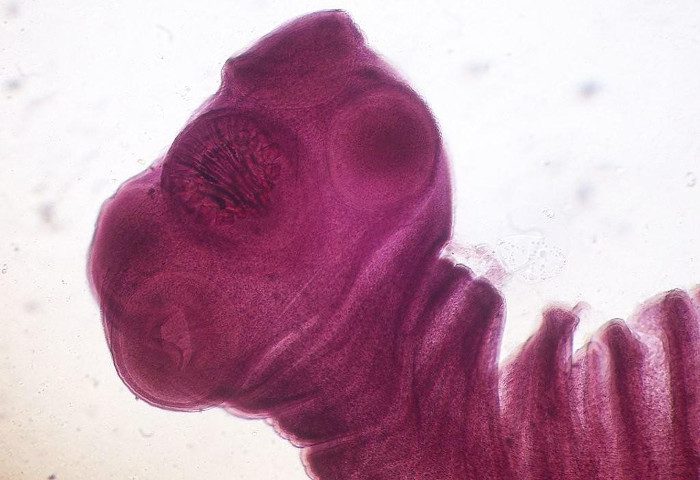
Pork tapeworm – the largest parasitic worm that can infect humans.
Taenia solium – also known as the pork tapeworm – is the largest parasitic worm that can infect humans, growing up to 10 meters in length.
As the name suggests, they live as parasites in pigs and can infect humans when consuming undercooked meat containing larval cysts. Upon entering the stomach, the cysts develop and thrive on the nutrients from our daily diet.
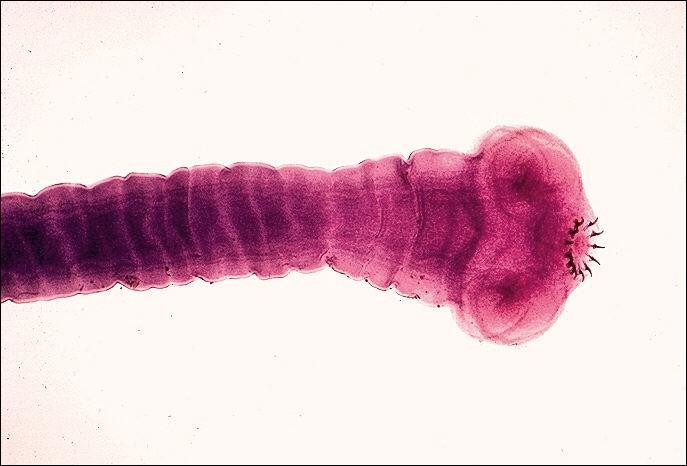
Cysts develop and thrive on the nutrients from our daily diet.
If ingested, the tapeworm eggs will tend to migrate throughout the body before hatching into cysts, potentially even reaching the brain.
This process is extremely dangerous, as tapeworms have been shown to cause epilepsy in humans. This is also one of the primary causes of epilepsy in developing countries worldwide.
When infected with the tapeworm, if it resides in the brain (which occurs in 60-96% of cases), it can lead to neurological issues such as headaches (48.4%), seizures (6.2%), psychiatric disorders (5.2%), visual disturbances (15.6%), memory loss (28.1%), and muscle spasms (34.3%).
Additionally, the larval form can also be found under the skin and in muscles, accounting for 18.57%, primarily in the diaphragm, tongue, deltoid muscle, torso, limbs, and the scalp…
2. Dog Tapeworm (Echinococcus granulosus)
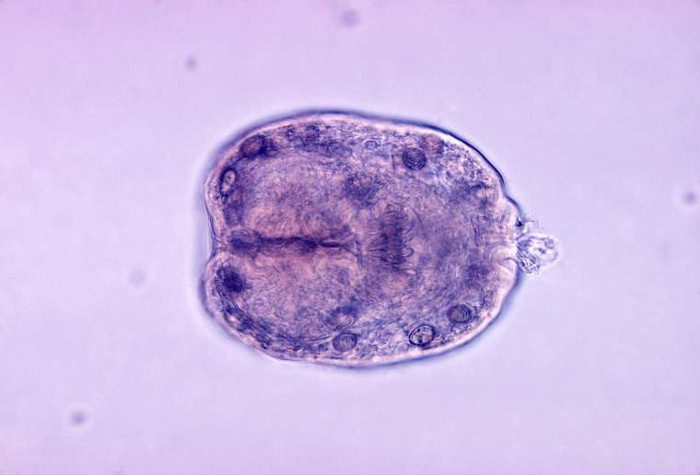
Echinococcus granulosus is only 3-7mm long but extremely dangerous.
The dog tapeworm (Echinococcus granulosus) measures only 3-7mm in length but is highly dangerous. They can grow and develop in livestock such as sheep, cattle, and horses, but primarily in dogs, hence the alternate name: dog tapeworm.
Humans become infected with the dog tapeworm by ingesting their eggs (which may come from contaminated meat or direct contact with dog feces). Once inside the body, the eggs hatch into parasitic cysts in the liver, forming tumors.

Millions of cases of dog tapeworm infections occur worldwide each year.
This species is dangerous because the tumor development process is relatively slow, taking years to show clear symptoms. The tumor can contain several liters of fluid, and if it ruptures, it poses a life-threatening risk.
Each year, millions of cases of dog tapeworm infections occur worldwide, primarily in countries where livestock are in contact with dogs or in countries that consume dog meat, such as China, Thailand, and Vietnam…
3. Mouse Tapeworm (Echinococcus multilocularis)
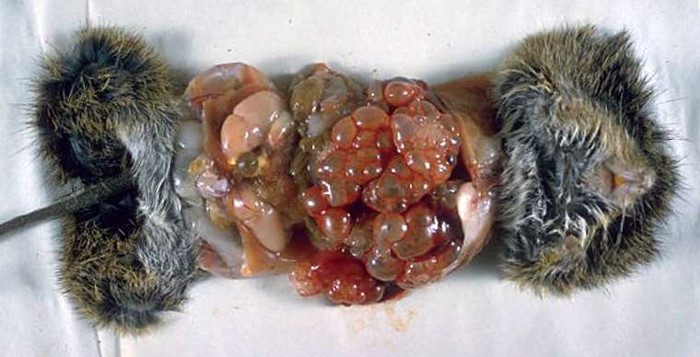
Clusters of tapeworm cysts in the host’s body.
Echinococcus multilocularis belongs to a genus of small tapeworms, distributed sporadically worldwide, including developed countries in Europe and America. This species lives as a parasite in various wild animals like foxes and squirrels but can also infect dogs, cats, and rodents.
Upon entering the body, they generate numerous cysts in the liver and other internal organs, spreading rapidly and mimicking cancer symptoms. If the cysts are not surgically removed, the host will die very quickly.
For this reason, those who enjoy “delicacies” such as dog and rat meat should exercise caution before eating. Additionally, tapeworms can enter the body through unwashed vegetables or foods containing eggs.
4. Protozoan (Cryptosporidium)

Cryptosporidium is a genus of single-celled protozoa that typically live in the intestines of livestock such as cattle, pigs, and goats.
Cryptosporidium is found worldwide. They spread through contaminated water or food washed with infected water. Additionally, unpasteurized milk and shellfish like clams and oysters can also serve as intermediaries for this protozoan.
When infected with Cryptosporidium, patients experience severe diarrhea and other gastrointestinal symptoms. To avoid this parasite, experts recommend thoroughly washing food before preparation and avoiding untreated water (boiling or filtering water).
5. Amoebic Dysentery (Entamoeba histolytica)
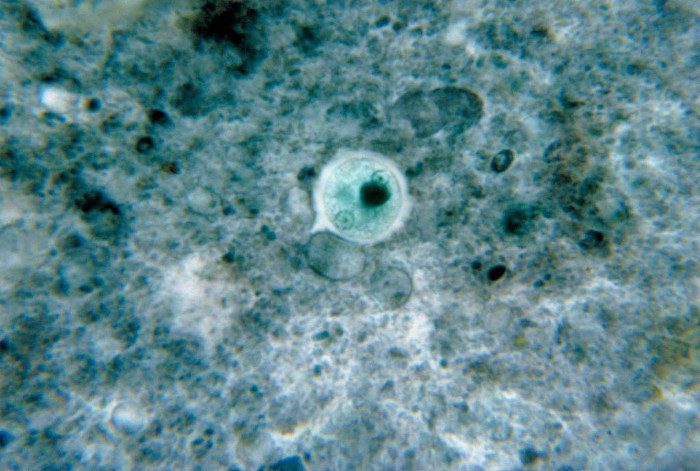
Entamoeba histolytica spreads through contaminated water sources.
This parasite causes a very dangerous disease known as dysentery, with very characteristic symptoms such as bloody diarrhea and prolonged pain. Additionally, amoebic dysentery can inhabit various other organs such as the liver and kidneys, leading to severe complications.
Similar to Cryptosporidium, Entamoeba histolytica spreads through contaminated water sources or unhygienic foods.
Moreover, flies are also very effective carriers as they land on everything – from… human waste to people’s food.
6. Trichinella (Trichinella spiralis)
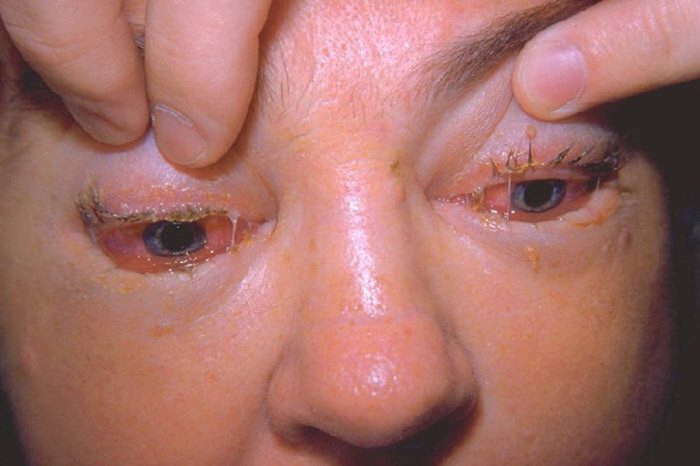
We become infected with this worm if we eat undercooked pork infected with the worm.
Trichinella spiralis is a type of roundworm, also known as pig roundworm, as they primarily live as parasites in pigs. We become infected with this worm if we consume undercooked pork infected with the worm or eat raw foods like smoked meat.
Once inside the body, the roundworms lay thousands of new larvae, hiding in our muscles. As a result, patients may experience headaches, fatigue, muscle pain, and swelling of the eyes. If complications affect the heart, the patient’s chances of death are very high.
7. Liver Fluke (Opisthorchiidae)
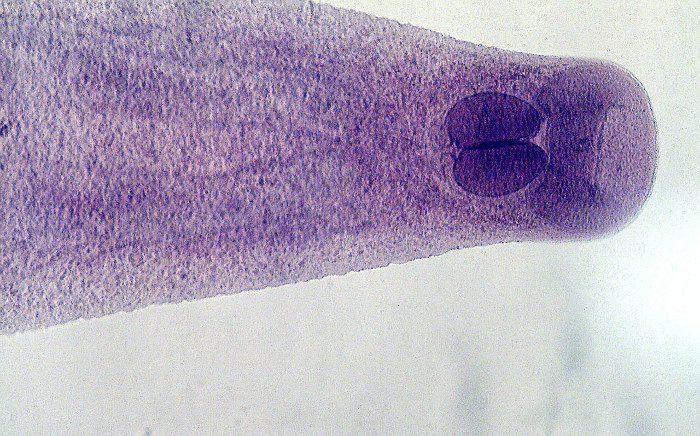
We become infected with liver flukes when consuming undercooked river or lake fish.
Unlike the pork tapeworm, we become infected with liver flukes when consuming undercooked river or lake fish or when eating dried, salted, or smoked fish. These fish do not inherently harbor flukes but can become infected when consuming snails that contain fluke eggs.
Once inside the human body, liver flukes “anchor” themselves in the bladder and gallbladder, subsequently laying eggs in human feces. The eggs then enter water sources through feces to begin a new life cycle.
Liver flukes do not cause specific symptoms in the short term, but in the long run, they are responsible for causing liver and gallbladder cancer in humans.
8. Ascaris Roundworm
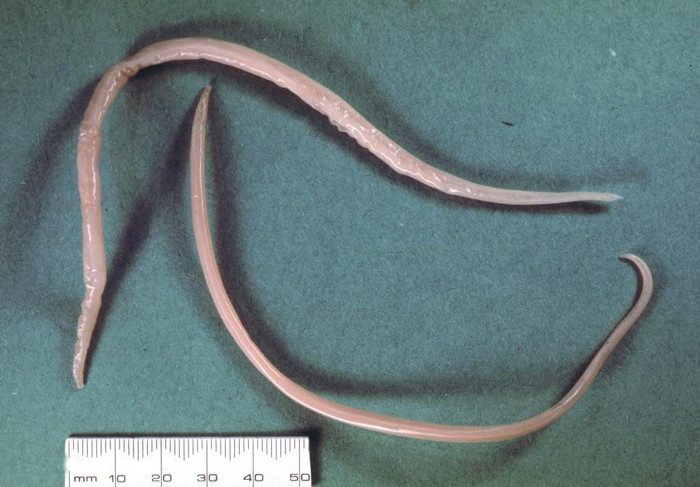
Ascaris roundworm is the largest parasitic roundworm that can infect humans.
Currently, up to 25% of the world’s population is infected with this type of worm. The Ascaris roundworm is the largest parasitic roundworm known to infect humans, reaching lengths of up to 25 cm.
Once it enters the body, the worm’s eggs hatch into larvae, which travel through the bloodstream to the lungs and then “invade” the trachea connecting to the throat.
The larvae are then “swallowed” back into the stomach and intestines, where they develop into adult worms.
The female Ascaris can lay thousands of eggs each day, which are excreted into the environment through feces. If contaminated food containing the worm’s eggs is consumed, the Ascaris will continue to spread within the community.
The level of danger posed by Ascaris depends on the number of worms present. In some cases, Ascaris can enter the bile ducts, causing blockages and severe pain. If the “community” of Ascaris worms becomes too large, it can lead to intestinal obstruction, which can be life-threatening.
To prevent parasitic diseases, Dr. Le Van Thieu from the Department of Infectious Diseases at the Central Tropical Diseases Hospital recommends the following measures:
- Maintain a clean living environment
- Practice good hygiene when eating
- Avoid consuming undercooked foods such as fish salad or blood pudding
- Always wash hands thoroughly with soap before and after using the restroom
- Limit free-range pigs; if raising pigs, follow proper waste management procedures and separate the living area from the environment
- Regularly deworm
How to Treat Tapeworms in Humans


















































